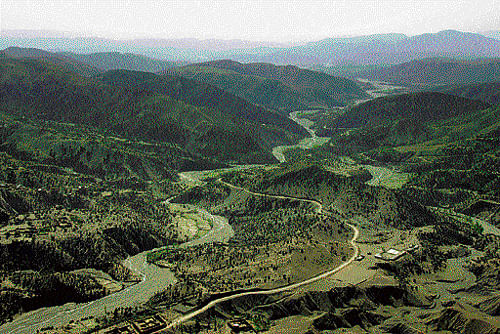
Fatima Bhutto’s debut work of fiction, ‘The Shadow of the Crescent Moon,’ revolves around the lives of ordinary people in Waziristan that is ravaged by religious politics, writes Monideepa Sahu.
In this striking novel set in Pakistan’s frontier province of Waziristan, Fatima Bhutto attempts to bring to life the myriad aspects of life on opposing sides of strife. The intriguing opening draws readers into a world of apparent normalcy, a small town where the bazaars are opening to accommodate last minute Eid shoppers. Yet ominous forces cast heir shadow upon this community of ordinary people going about their daily business. The “fog makes it seem as though the tanks aren’t there at all. On the roofs of the town’s buildings, snipers lie in their nests, surrounded by sandbags.”
This is a world where religion has become politicised. People now choose their mosque carefully. “Fridays were no longer about the supplicants; they were about the message delivered to them by faithful translators of the world’s clearest religion.” Men of Pakistan’s frontier regions like Inayat and Ghazan Afridi felt that they were treated by those in power as barbarians. They knew that ‘democracy’, ‘development’, ‘reconciliation’ and ‘devolution’ were mere words, new ways used by the government to “use our own people against us.” Men like them dedicated their youth to struggling against oppression. The state began fighting its own. “Town by town, civil wars were lit by the wide-scale violence of the army — a violence that spanned decades and finally reached its zenith in the War on Terror.” Peaceful dissident professors, students and intellectuals were illegally captured by the government authorities to join the ranks of the undead, the missing, and the unknown. Or, like Azmaray, their brutalised and mutilated bodies were left on university campuses to serve as public warnings.
The struggle against state oppression becomes diluted and corrupted by the generation succeeding Inayat and Ghazan Afridi. The militants “were fighting the excesses of a corrupt, godless nation. They did not flinch from violence. They beheaded soldiers and kidnapped brigadiers.” They also confiscated money and bootleg alcohol, killing the local “Sikh and Christian minorities that survived on this trade, and sold the rusted cans and glass bottles to enlarge their own caches”. They take money that mosques raise from their poor congregations, and welcome foreigners from “bright green countries that dutifully supported their cause to the tune of millions. There was little by way of violence and corruption that separated them from their enemies.”
This novel spans the startling events of a single day in the lives of Inayat’s three sons and Ghazan Afridi’s daughter Samarra. The author deftly moves the narration back and forth, using flashbacks to trace developments in the lives of these young people striving to live and love in the throes of rebellion. Inayat’s three sons have chosen different stances on the ongoing conflict in their homeland. The eldest, Aman Erum’s quest for “success, comfort, respect” and freedom from the restrictions of life in a small border town leads him to sell his soul as an informant to Colonel Tarik of the Pakistani intelligence. In exchange for a passage to the US to seek a coveted foreign degree, he makes the deal himself, eagerly dropping “his country like a weight off his back.” He sacrifices and later betrays his childhood sweetheart Samarra, who becomes the object of the youngest brother Hayat’s affection. Samarra and Hayat take on the burden of their fathers’ struggle to free their homeland. These two idealists face danger, disenchantment and pain. Aman Erum’s second brother Sikandar chooses the middle path as a doctor striving to practice the profession of peaceful healing in his ravaged homeland. Yet violence overwhelms him, snatching his young son in an act of terror.
The author tells their stories in polished prose. Some memorable passages bring to vivid life the characters and their world. We feel for the characters and can understand, if not always agree with, their actions and motivations. However, one wishes also to know them better, to get more glimpses of their inner lives. We could, for example, look deeper into Sikandar’s love for his son and wife, and the reasons for his staying on in his homeland, while many of his colleagues migrated abroad.
Samarra is a strong and memorable character; the tomboy who evolves into a beautiful, confident and complex young woman capable of powerful emotions. Sikandar’s wife Mina, in contrast, is quite flat. Crazed by the loss of her child, she goes to the funerals of strangers, hoping to understand her loss. The older women, Malalai and Zainab, are also one-dimensional, quietly coping and keeping the home fires burning in the background. Colonel Tarik and the Taliban leader, who intercepts Sikandar on a mission of healing, have immense potential. As the novel stands, we get only the briefest glimpses of them. Explorations of the mind behind the spy kingpin’s hand that turns the wedding band on his finger as he recruits traitors and tortures innocents, would enrich the narrative. The Taliban leader lets Sikandar and Mina go, when Mina’s hysterical rants remind him of his role in the misdirected attack which killed Mina’s child. Delving into the human side of a hardcore extremist would offer another unique perspective on the many facets of war and violence.